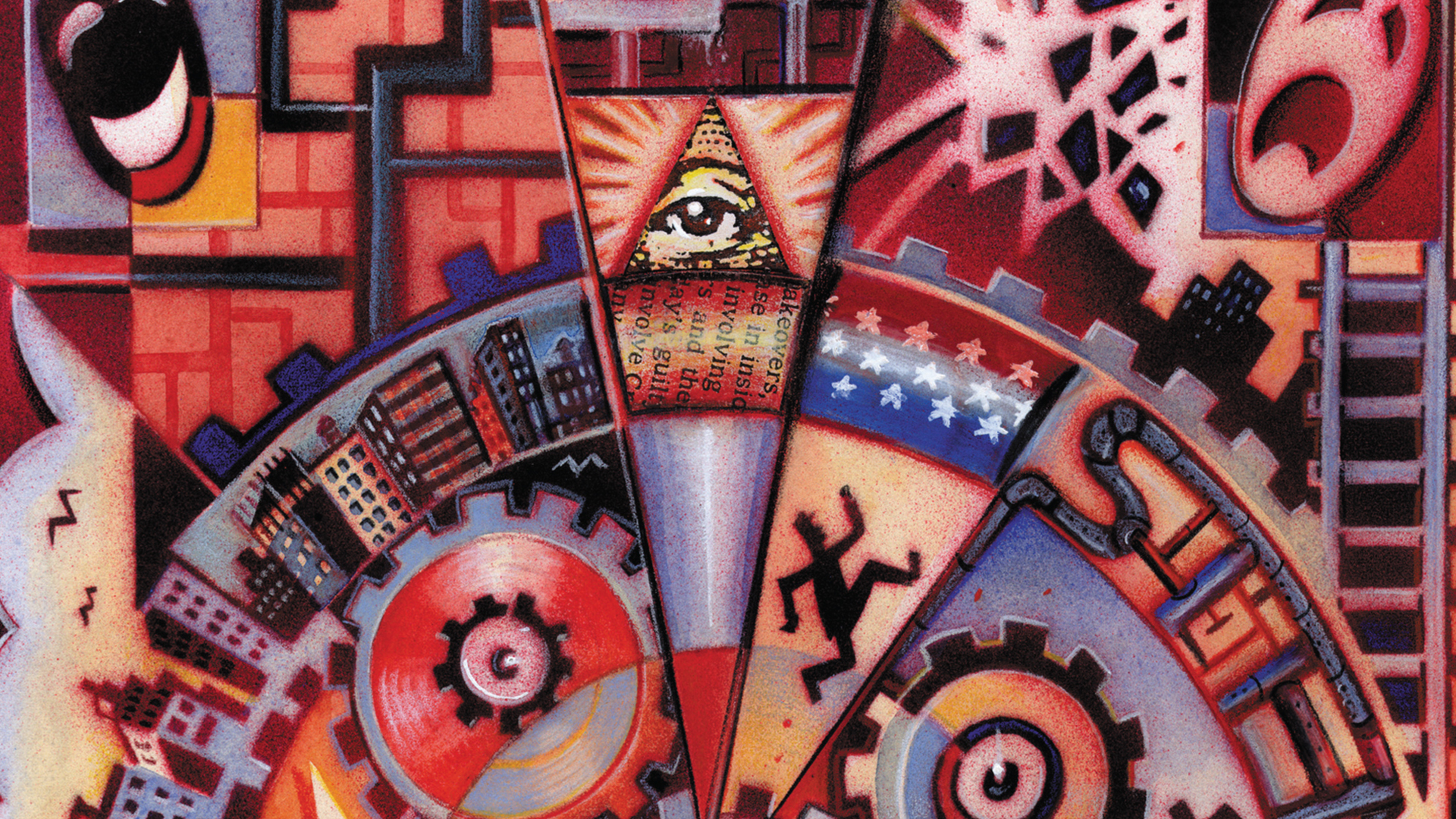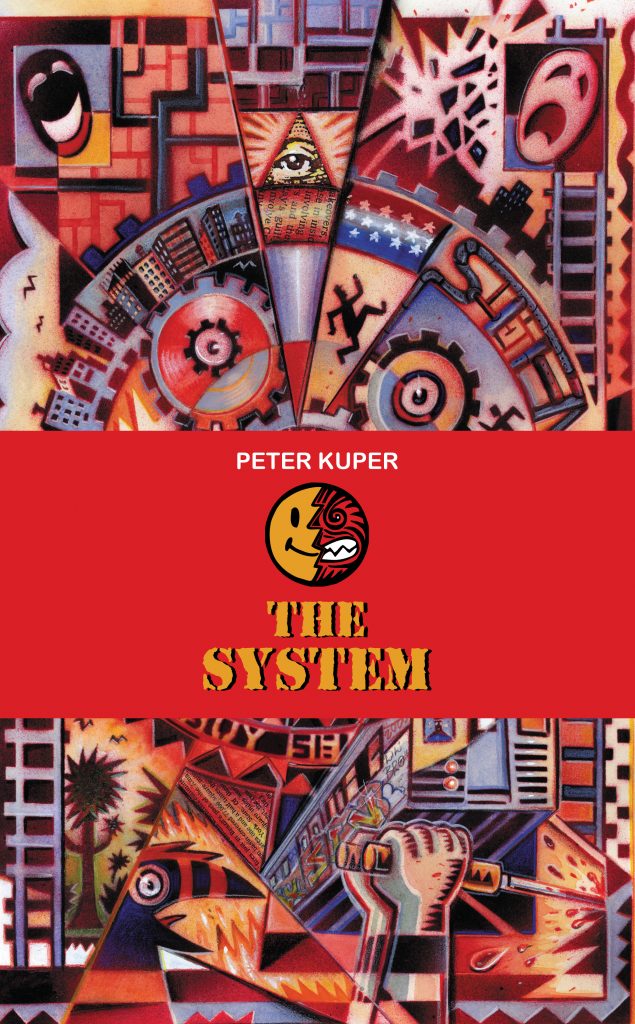By Rob Clough
High-Low
October 7th, 2014
In some ways, Peter Kuper’s The System
is very much of its time with regard to its view of New York City.
Written in 1995, its Times Square is still sleazy and the city
(especially its downtown area) was far less gentrified than it is now.
That said, its central plot beats–police corruption, racially-charged
violence, insider trading, the threat of terrorism–are still all too
familiar. This is my favorite of all of Kuper’s comics, as it synchs up
his interests in urban storytelling, political rabble-rousing, silent
storytelling and his personal relationship with New York. It’s also his
most visually inventive and ambitious, as he spray-painted stenciled
sheets to get a gritty, graffiti-inspired effect on each page. Given
that the visual theme of the book is the way seemingly random people
and things intersect and affect each other, the fact that colors
literally bled into one another from panel to panel only helped to
reinforce this theme.
While The System is touted as a silent book and there is no dialogue, it’s a bit of a cheat to say that it’s wordless. Indeed, there are whole subplots of the book that take place in headlines, on newstickers and on TV screens that drive a great deal of the action. We learn that a detective investigating the murder of a stripper is guilt-ridden for accidentally shooting a boy by looking at the newspaper clipping he carries around detailing the incident. We learn that there’s a presidential election coming up between the corporate-sponsored incumbent and his firebrand liberal counterpart, and we later learn of the challenger’s tragic fate from the papers. We learn of a major battle between two corporate giants who are trying to take over a third company via computer screens and iconography. This isn’t a knock against the book; indeed, the omnipresence of media is a reality in an urban setting. That said, this is a book that requires different kinds of reading and rewards readers for keeping track of small details.
There’s an orderly sense of chaos in how Kuper designs his pages. He
resolutely stays away from any set sort of grid pattern on a page to
page basis. In the second chapter, a brutal race-related murder is
framed such that the panels are all askew, as though they were rocking
or vibrating. Some of his panel-to-panel transitions are simple, while
others are more dramatic and abstract, like the scream of a murder
victim giving way to the tracks and train of a subway. A pigeon is his
go-to way of moving the action somewhere new, as the bird draws away our
eyes when Kuper simply wants to shift scenes without having characters
intersect.
Peter Kuper’s New York is one with predators, prey, and those
in-between, trying to live their lives. Some of the characters meet
horrible and unjust fates. Others have surprisingly sweet happy endings.
Some of the corrupt are busted, while many more of the corrupt
continue to exploit and profit off of others. Some murderers walk away
clean, while others are punished in the most dramatic and ironic ways
possible. Kuper’s amazing achievement is keeping over a dozen different
stories tightly wound around each other, effortlessly weaving them in
and out of each other over the course of a few days. Some of the
stories are a bit on the broad side and even feel a bit silly (like a
corporate saboteur being brought in to nuke a competitor’s building),
though after the events of 9/11, who can say what’s broad? Relying on
simple visuals means Kuper can’t afford much in the way of restraint or
subtlety, neither of which were ever his strong suit to begin with. In
the system, he uses that bluntness effectively and beautifully, making
each and every page look like a beautiful bit of street art. Street
art is frequently simple, bright and direct, and that’s what Kuper aims
for here. That said, he also manages to throw in a murder mystery, a
political thriller, a cop procedural and various other kinds of stories
into the book all at the same time, and pulls each of them off
seamlessly. More than any of his other comics, The System is
admirable simply because of the beauty of its structure. I do think that
the final-panel reveal of a (literal) ticking time-bomb was a tad on
the ridiculous side and betrayed the cyclical nature of the storytelling
in the rest of the book. It was too much an “end of history” moment
for a book that essentially showed that at any given time in the city,
there’s a cycle of predators and prey, lovers and artists going about
their day, the rich trying to exploit the poor and certain elements of
the underclasses that try to fight back in their own ways. By teasing an
explosive game-changing end felt a bit cheap and went against the
grain of the rest of the book. That said, the rest of the book worked
as a distillation of much of Kuper’s career as an artist and editor.
This edition was published by PM Press; Vertigo originally published it as three monthly issues and then later a collection. This edition is in hardback, is printed at a larger size and on better paper. The colors absolutely pop off the page in this book, and the quality of the paper is a big reason why. The endpapers, commentary and interstitial material give the book a real chance to breathe. This is obviously the definitive version of this book, and I’d point any reader curious about Kuper’s career to this book first and foremost.










